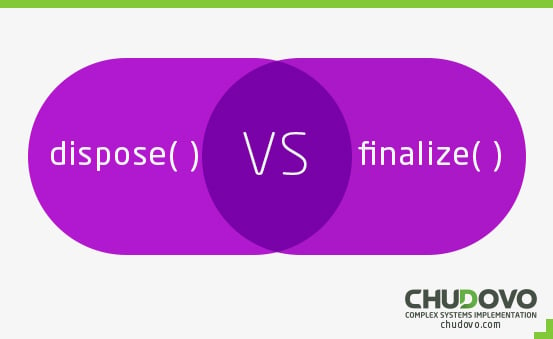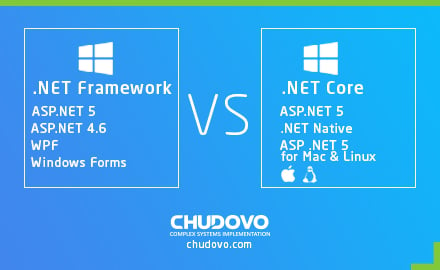C# vs VB.NET. Practical differences
Table of contents
.NET, a software development framework is an incredible creation by Microsoft that perfectly fits its ultimate goal “One platform for all languages.” As of now, the platform supports more than 50 languages including both functional and object-oriented. Out of all, the two most important are C# and VB.NET. Though both the languages are part of the .NET framework and are developed by Microsoft, the two are syntactically very different.
C# is a general and modern object-oriented programming language that runs on the .NET framework. It is pronounced C-Sharp and is designed to make the platform run faster to get new and quality products in the market. VB.NET, on the other hand, is an object-oriented programming language implemented on the NET. Pronounced as Visual Basic.NET, it helps in the quick .NET development of applications. This article deals with the comprehensive difference between C# and VB.NET for better understanding.
C# vs VB.NET language comparison
Choosing the right programming language between C# and VB.NET is always a war of words for the .NET developers’ community. While C# is more often come out as a vigorous winner, VB.NET, at the same time, is no less significant for developing applications. That being said, the choice between these two primary languages is undoubtedly a tough row to hoe. Thus, before delving deep into the concept of C# vs VB.NET, let’s grasp their basic meanings, features, and functionalities.
VB.NET
VB.NET is a simple object-oriented programming language that stands for Visual Basic.NET. It was developed by Microsoft in 2002 as a successor of Visual Basic 6 language. Meant to implement on the .NET framework, the language supports extensive features such as polymorphism, abstraction, inheritance, and encapsulation. It has full access to the .NET libraries and is a great tool for .NET developers to develop dynamic applications for Windows, mobiles, web.
One of the best things about the VB.NET programming language is that it runs on Multi-platforms. This means other than Windows, it also effectively runs on platforms like Linux and Mac OS. Some of the other advantages include automatic formatting of VB.NET code, standard library, improved object browser, and modern features like events logs, file system, docking, and more.
The fact that it is able to build robust, secure, and high-performance applications makes it sometimes a better choice in contrast to VB.NET vs C# performance.
C#
C# is a modern, general-purpose programming language used on Windows .NET Framework. Developed in 2000 by Microsoft, it was originally meant to overshadow Java. However, as of now, C# is able to accomplish a wide range of tasks and objectives, most importantly creating programs and applications. The three areas where the language is significantly used are website development, games, and windows applications.
The reasons that make .NET developers shift their interest towards C# programming languages have a low learning curve, scalability, time effectiveness, and large community. However, in comparison to C# vs VB.NET., beginners still prefer the latter for its lack of cryptic syntax and easier reading of VB.NET code, though the job demand for the former is more.
Comparison Between C# and VB.NET
No doubt, both .NET languages hold phenomenal advantages and are great tools to accomplish software tasks. But the difference between their syntax and keywords makes one a better performer in the race of C# vs VB.NET.
Syntax Differences
VB (Visual Basic.NET) is quite a simple language to understand for it resembles the basic English language. Unlike other languages including C#, it mostly uses words like AND. C#, on the flip side, is a part of the C family and owns the features of Python, Java, and C++.
Moreover, in contrast to VB.NET vs C#, C# is case sensitive, while VB is not. Below are the two examples of the features that prove the fact.
- Shadowing
In VB (Visual Basic.NET), the Shadow feature helps a developer provide a new implementation of a base class member without overriding a member. By using the keyword ‘Shadows’, one can allow a base class member into a derived class. The point to be noted is that the return type of the shadowed member is not the same as the base class member.
Shadow feature is not supported in C#.
- Hiding
Hiding is a C# concept and is also known as method shadowing. It is the feature by which a developer can allow a new implementation of a base class member without overshadowing a member. By using the keyword ‘new’, the implementation of the methods of a base class from the derived class can be hidden.
The hiding feature is not supported in the VB.NET programming language.
Keyword Differences
Writing syntax is different for both languages. Here are some examples of the differences between C# and VB.NET keywords.
- To declare a variable, ‘declarators’ is used in C#, whereas, ‘Private, Public, Friend, Protected, Static 1, Shared, Dim’ is used in VB.
- To create a new object, ‘New’ is used in C#, whereas ‘New, CreateObject ()’ is used in VB.
- To refer to the current object, ‘this’ is used in C#, whereas, ‘Me’ is used in VB.
- To retrieve characters from a string, ‘[]’ is used in C3, whereas, ‘GetChar Function’ is used in VB.
- To declare a class, ‘Class’ is used in C#, whereas, ‘Class is used in VB.
Key Difference Between C# and VB.NET
Check out the informed comparison between VB.NET vs C#.
| C# | VB.NET |
| It belongs to the C family and is pronounced as C-Sharp | It is an updated version of Classic Visual Basic 6.0 and is pronounced as Visual Basic.NET |
| C# uses C-based syntax | VB.NET uses simple English in its syntax |
| C# is a case-sensitive language | VB.NET is not a case-sensitive language |
| It supports structured error handling | It supports structured and unstructured error handling |
| Event handling is a bit complex in contrast to VB.NET | Event handling is simpler |
| Events are not possible in C# | Events are automatically bound |
| Each statement does not terminate with a semicolon | Each statement ends with a semicolon |
| There is a need for a lot of casting and conversion to write the same lines of code in C# | It is easy to write VB.NET code with the use of implicit casting |
Features of Visual Basic .NET
When developers convert C# to VB.NET, they lose nothing but semicolons. But the bigger picture is that they get to relish some top-hole benefits like fewer restrictions, quick coding, and more. All this is because of the A-list features of Visual Basic.NET. Take a look.
- VB.NET is an object-oriented language, which means it treats everything like an object.
- It is not a case-sensitive language as in the case of C++ and Java. This makes VB.NET a clear winner in the race between VB.NET vs C# popularity.
- VB.NET structures are composite types. In other words, VB.NET structures contain a number of elements of other types. Fields, constants, methods, indexers, properties, operators, and constructors are some of the significant constituents of the VB.NET structure.
- VB.NET structure.
- VB.NET code automatically gets formatted.
- It contains a standard library.
- In VB.NET, garbage collection is automatic.
- It allows applications to deal with multi-tasks at the same time.
- It supports event management.
New Features
In addition to basic features, the VB.NET programming language supports some modern features that help a developer accomplish tasks easier and faster. These innovative features make VB.NET better in the race of VB.NET vs C# performance.
- Inheritance
Inheritance is the feature by which developers can add an existing VB.NET code base for expanding the functionality. With this, a class can only be defined once. Developers can reuse the functionality by deriving new classes. Visual Basic.NET fully supports inheritance.
- Type Safety
It is a type-safe language. By type-safe, it means that VB.NET code can only access memory locations when it is permitted to access. This feature makes the VB.NET programming language secure with no unwanted side effects.
- Window Forms
Developers can inherit a new form from an existing form with VB.NET. It is because of the new forms package – Window Forms.
- Assemblies And Namespaces
Assemblies containing the Namespaces are the basis of code deployment. It contains MSIL code and also defines the name for the DLL file. Namespaces are a collection of names, which are used to eliminate the confusion of defined classes.
- Attributes
Attributes are the tags meant to present additional information about the defined elements in Visual Basic.NET.
Features of C#
In terms of event handling, writing code, auto-correction of techniques, and interoperability, VB.NET is a winner in the game of C# vs VB.NET. But all this doesn’t make C# any less of a phenomenal language for building applications on the .NET framework. Below listed are the top features of the C# language that makes it popular among developers as a modern software solution.
- Simple
C# is a simple language containing a rich set of library functions and data types. In the C# programming language, unsafe operations are not allowed. Besides, there are no pointers and no usage of “::” or “->” operators.
- Modern
In comparison to C# vs VB.NET, the former is definitely modern as it is based on the current programming trends. This is the reason, some developers don’t find it useful to convert C# to VB.NET. Moreover, C# can also turn any component into a web service with its built-in support. All in all, it is a great tool to build robust and dynamic applications.
- Type Safe
There is no difference between C# vs VB.NET in terms of the security of the program. It is because of the Type-Safe feature being supported by both the languages.
- Interoperability
C# programs are capable of doing anything that native C++ applications are not able to perform. Interoperability is the reason behind this.
- Scalable and Updateable
The best part about the C# programming language is that it is automatically scalable and updateable. Developers need to delete the old files and update them into new ones without registering to the dynamic link library.
Conclusion
C# and VB.NET are the two most indispensable languages for the .NET developers’ community. These are the reasons developers can build and present robust applications for web, mobile, and Microsoft. However, the ongoing debate between the two often confuses both beginner and intermediate developers to make a choice. After all, there are quite a few syntactical differences between C# and VB.NET.
Deriving the results from the above-said facts about C# vs VB.NET, it goes without saying that the latter is a winner in many cases. Beginners can plump for VB.NET for easy VB.NET structures and syntax. However, if one is looking for a modern solution which along with updated features can also provide great job opportunities, C# is a better choice in the race between VB.NET vs C#.






